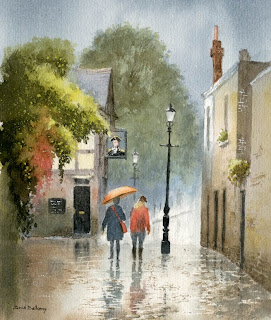One of the little subtleties I enjoy putting into my paintings is that of counter-change, sometimes simply to create a variation and sometimes out of necessity. In my recent workshop demonstration at Shopkeeparty I employed the technique for both these reasons in the painting of a farm in Nant Ffrancon.
This is the central part of the watercolour, and you can see the slate fence in the right foreground with two of its uprights light against a darker bush, while the rest of the uprights are dark against a light area of the farmyard. I could just as easily painted the two left-hand uprights dark and it would still have worked, so in this case it was painted like that just to include a little variation.
If we now move across to the barn on the right of the composition you will see that the roof has been painted dark of the left-hand side where it stands in front of a light background, and then the roof is depicted light on the right-hand side against a dark background. In this instance it was necessary to introduce counter-change to make the roof stand out at both ends. This is an extremely useful device to have in your artistic armoury, so try to incorporate it into your work whenever you can.
I have further Shopkeepeasy workshops coming up in early May and you are welcome to join in. The first is on Thursday 6th May at 2pm, is free to Shopkeeparty patrons and lasts 45 minutes, which you can check out at Mountain Stream with David Bellamy (shopkeeparty.com) while the second one which lasts between 2 to 3 hours is on Thursday 13th May at 3.30 pm, which you will find at Workshop: Autumn Waterfall with David Bellamy (shopkeeparty.com) for which there is a charge. Both events will feature a mountain stream with a cascade or waterfall.
I hope you are all able to get out into the countryside to paint and sketch now that things are easing up.




